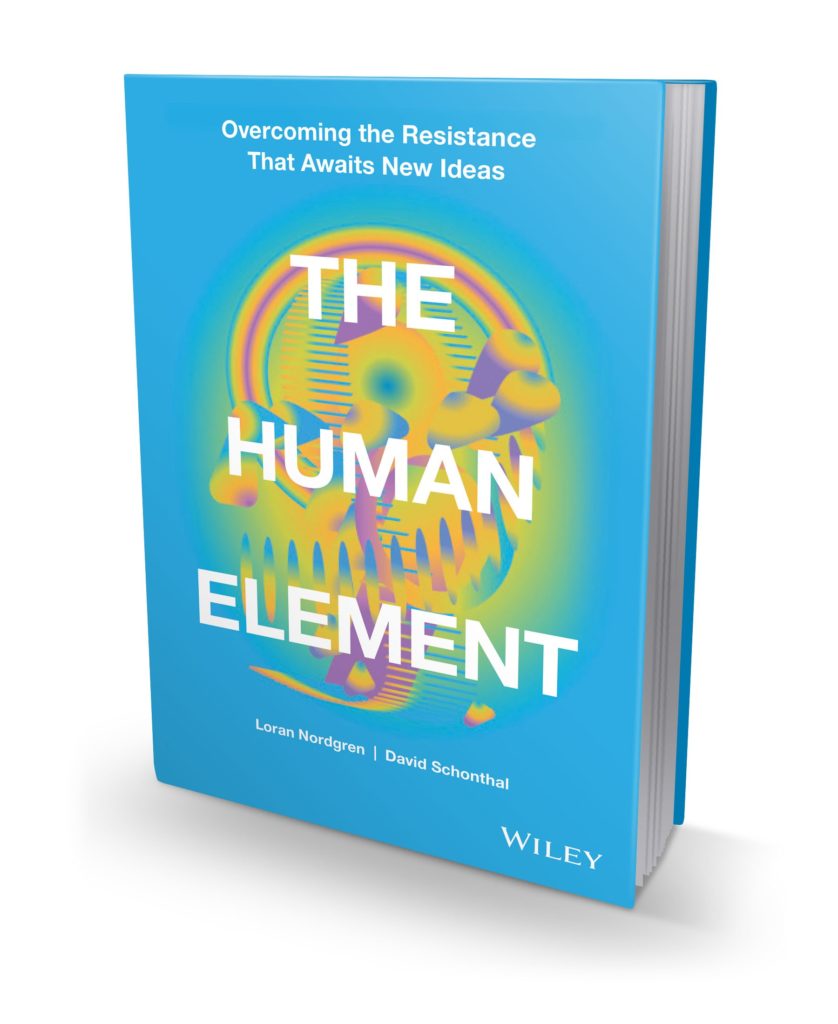How can removing friction get people to adopt something new?
In David Schonthal’s new strategically thoughtful book called The Human Element, he attacks the deep assumption of most marketers, innovators, executives, activists, or anyone else in the business of creating change. Along with his co-author Loran Nordgren, their new book brings a refreshing view of marketing innovation and new ideas.
David teaches strategy at Northwestern’s Kellogg’s School of Management and is involved in venture investing. He also works with IDEO to tackle how to get a more significant impact with earlier-stage companies. His co-author, Loran, is a professor of management and organization and an expert in influence and persuasion.
Why do people so quickly say NO to a good idea?
The traditional approach to selling an idea is to focus on heightening its appeal. We instinctively believe that if we add enough value, people will say “yes.” So, this reflex tends to lead us down a path of adding features to an idea and amplifying its benefits to get others on board. These activities and strategies are designed to generate demand. In the book, Schonthal refers to this notion as “fuel.”
But it takes more than fuel to start a fire.
Removing Friction, not just Adding Fuel
But by focusing on fuel to enhance attraction, innovators often neglect the other half of the equation – the frictions that work against the desired behavior we seek in others. Frictions are the psychological forces that oppose and undermine change. Though rarely considered, identifying, understanding, and overcoming these frictions is often the key to successfully achieving our innovation goals.
In his book, readers will discover the four frictions that operate against new ideas and innovation:
4 Primary Sources of Friction – The Headwinds
INERTIA –The powerful desire to stick with what we know, despite the limitations. The reluctance to change the status quo. A powerful human bias. Covid forced people to do things differently quickly, like buying groceries online or working remotely. Habits are hard to change, Covid became a ‘forcing function’ – telemedicine is another example. Hard-coded habits are up for discussion.
EFFORT – The energy (real and perceived) needed to make change happen. How much exertion is required? Getting people to change behavior means power and action must be exerted in a new place. And it is much easier to say no when the benefit requires so much exertion. (think of how much easier it is to try the software for free for 30-days versus paying for it upfront)
EMOTION – The unintended negative emotions created by the very change we seek – fear and anxiety. Worrying about what change means often makes it far easier to stick to what you are doing versus having to experience an onslaught of stress and an emotional flood.
REACTANCE – The impulse to resist being changed. People’s aversion to being changed by others. We know vaccines work and are effective. Masks have an impact yet – even though the data people are reluctant to change. Most people think – they don’t understand the data. So we tell stories and overwhelm them with data. But that doesn’t change their behavior. One of the truths of reactance is that reliable data won’t make a difference because of autonomy. More data has the opposite effect. Data doesn’t make a difference. Let’s understand how to defuse reactance.
There is a terrific example in The Human Element about understanding the friction in adopting a new product. A hipster furniture maker who creates custom sofas for apartment dwellers found that his target loved his product. The price was right, the designs matched their desires – but somehow, most orders ended up in the shopping cart online, and they few clicked buy. Through interviews with customers, the owners learned that what was stopping people from purchasing, was the dilemma of how to remove their existing sofa and to lug it down four flights of stairs? Figuring out how to remove the old furniture, became as important as the price, design, and style of the new.
By examining these frictions, readers will understand the unexpected reasons why the ideas and initiatives they are most passionate about get rejected. Readers also will learn how to identify and disarm these forces of resistance and will discover how the very frictions that hold us back can be transformed into essential catalysts for change.
Hiring A Product
The opposite of emotional friction is emotional value. When we hire a product to do a job, it performs three vectors values for us: Functional, Emotional, and Social Value.
Functional – the features and value that give us value for our lives. These are the transactional things that the product or service does for you. A coffee maker makes coffee. A pool is a place to go swimming in your backyard.
Emotional and Social Value – Social and emotional value of a thing creates far more gravity. Ask why someone bought a pool or “hired a pool” during the pandemic, they say that they wanted to have a social life, see our friends, a pool purchase becomes that place.
The purchase wasn’t about the pool but more about the social behavior, town square, and social circle. People buy products not just function, they hire a product or service to make a progress in their life toward emotional and social functional needs.
The Human Element shows that the other meaningful side of innovation – is overcoming human beings’ natural aversion to anything new.
How good are you taking friction out of your product or service and do you understand the emotional value you create? The Human Element might add some fuel to help you create some sparks with your new idea.
You can set up a time to chat with me about your marketing challenges using my calendar. Email me jeffslater@themarketingsage.com Call me. 919 720 0995. The conversation is free, and we can explore if working together makes sense. Watch a short video about working with me.






